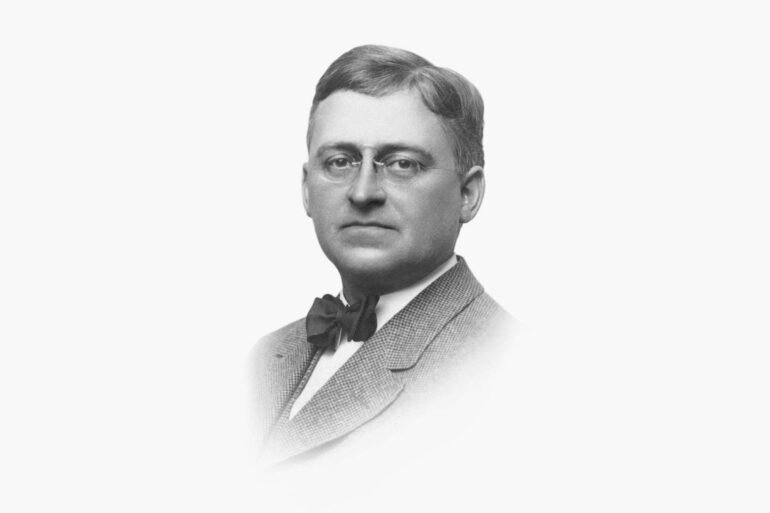James Ward Packard (1863–1928) was a prominent American industrialist, inventor, and watch collector. Best known as the founder of the Packard Motor Car Company, which manufactured some of the most luxurious automobiles of the early 20th century, Packard was also an avid horology enthusiast and one of the most influential watch collectors of his era. His rivalry with Henry Graves Jr. over acquiring the most complicated and exquisite timepieces played a pivotal role in advancing the art of watchmaking.
James Ward Packard was an engineer both in and out of the classroom. He wired the door and alarm clock of his dormitory room with switching mechanisms and rigged telegraph lines to friends’ rooms. Five years after graduating, he applied for the first of over forty patents.
Upon graduation he and his brother started manufacturing incandescent carbon arc lamps. In 1890, Packard opened the Packard Electric Company with his brother in their hometown of Warren, Ohio. Packard and his first business partner, George Lewis Weiss, initially purchased a Winton automobile in 1898. After experiencing multiple issues with it, Packard personally suggested improvements to Alexander Winton. When Winton dismissed him, Packard decided to build a better car himself, leading to the creation of the first Packard automobile.
Their company, the Packard Electric Company, made automotive electric systems. It was purchased by General Motors in 1932. The Packard Automobile Company was purchased by Studebaker and the last Packard automobile was manufactured in 1958.

Packard’s $1.2 million gift to Lehigh University led to the construction of the Packard Laboratory of Electrical and Mechanical Engineering. His legacy lives on there, in the ‘Ohio Model A’ (first made in 1898) on display in the main lobby, known affectionately as ‘Old Number One’.

This laboratory (below) was built in 1929 with the funds provided by Packard. He graduated from Lehigh with a mechanical engineering degree. While he attended Lehigh, Packard was fascinated with all things electrical and invented many clever lamps and alarm systems.

The building houses mechanical engineering and mechanics, electrical and computer engineering and computer science laboratories. It is headquarters for the College of Engineering and Applied Science.
Unlike Henry Ford, who revolutionized mass production, Packard emphasized precision engineering, luxury, and reliability. This is why Packard vehicles became known as some of the finest automobiles of their time. Unlike many flamboyant automotive pioneers, Packard was known to be quiet, reserved, and deeply focused on engineering. He avoided the public spotlight and let his work speak for itself.
During this time, Packard developed a deep interest in mechanical timepieces, becoming one of the most important clients of Patek Philippe. His fascination with intricate mechanics and complications mirrored his love for engineering. Packard worked closely with Patek Philippe to design watches that were technically and artistically groundbreaking. His commissions often included astronomical complications, perpetual calendars, and minute repeaters. They were some of the most sophisticated pocket watches of the time.

Perhaps one of the most famous watches he commissioned was the ‘Magnificent’ Astronomical Pocket Watch delivered to Packard on the 6th of April 1927. This open-faced watch with stem winding and setting, had the following complications:
- Minute repeating on three gongs
- Perpetual calendar
- Date (subsidiary dial at 6 o’clock)
- Day of the week (subsidiary dial at 6 o’clock; in English)
- Month (subsidiary dial at 12 o’clock; in English) – Age and phases of the moon (subsidiary dial, graduated from 0 to 29 1⁄2, aperture at 12 o’clock) – Time of sunrise in Warren, Ohio (subsidiary dial at 9 o’clock)
- Time of sunset in Warren, Ohio (subsidiary dial at 3 o’clock)
- Running equation of time
- Sky chart for the latitude of Warren (on the watch back, under the cover)
It has a yellow gold case, silvered dial, Dauphine numerals for the local time, painted upright Breguet numerals for sunrise and sunset, and a subsidiary seconds dial at 6 o’clock. It also features blued steel Poire hands and a blued steel counterpoised second hand, along with a gold “sun” hand for the running equation of time.
The rivalry that Packard supposedly had with Henry Graves Jr. is well documented, and it is often stated that this magnificent timepiece was a precursor to the Henry Graves Jr. ‘Supercomplication’ also made by Patek Philippe. However, the suggested date that Graves ordered his watch (in 1925) seems to have been before the date Packard’s watch was delivered.
They came from very different backgrounds, Packard, a self-made entrepreneur, and Graves, the benefactor of a Wall Street fortune. We will never know exactly who influenced who, but it certainly keeps things interesting and it is clear that they changed the game of watch collecting. It seems that Packard was keen to push the boundaries on the type of timepieces he commissioned as is borne out by the fabulous desk clock he ordered in the early 1920s – the age of ‘The Great Gatsby’ and beginning of the ‘Roaring Twenties’.

The stunning table clock made for Packard and delivered on the 7th of June 1923, has key winding and setting, with the following complications:
- Perpetual calendar
- Date (outer graduation, central hand)
- Day of the week (aperture at 9 o’clock; in English) – Month (aperture at 3 o’clock; in English)
- Moon phases (aperture at 6 o’clock)
- Leap year cycle (subsidiary dial at 6 o’clock)
- Power reserve indication (central sector)
The silver case, No. 601 324, with yellow gold applied decorative motifs, has a silvered metal dial, painted Roman numerals, subsidiary hour and minutes dial at 12 o’clock, and centre seconds.
It is accompanied by two keys and two calendar correctors. The clock case is chased and decorated with applied gilt flowers and scrolling acanthus leaves; its base is supported by winged gilt bronze griffons. J. W. Packard’s monogram, engraved and highlighted in blue enamel, appears underneath the dial in a triangle made of stylised, chased leaves.

The very special connection that Packard enjoyed with Patek Philippe over this period is
symbolised by two unique pieces – neither a pocket watch. This is Packard’s personal gold ring watch (above), made in 1917, and was the only known timepiece of its kind known to have been produced by Patek Philippe during this period.

A year later, Packard, who enjoyed regular walks near his home recording distance, time, and climate in a leather diary, ordered a cane watch (above). The singular piece was made of an ebony stick topped with a silver twist-off clock and a second knob made of ivory.
Packard was a great explorer and travelled extensively, predominantly by automobile – he took part in many road trips during which he would test out his automobiles, but he also enjoyed his time as a yachtsman often navigating Chautauqua Lake in New York (below).

It wasn’t just Patek Philippe watches that Packard commissioned. This exceptional Vacheron Constantin open-faced, two-train, 1/2-minute repeating grande and petite sonnerie chronograph clockwatch was made for him and delivered in 1918.

The nickel-finished two-train lever movement has 43 jewels, wolf’s tooth winding, bi-metallic compensation balance, micro-meter regulator, minute repeating on two gongs activated through the pendant, three levers in the band for lock/unlock of the chronograph function, grande/petite sonnerie and strike/silent, gold cuvette inscribed FABRIQUÉ POUR James Ward Packard, Warren, Ohio, 1918 PAR VACHERON & CONSTANTIN, GENÈVE – SUISSE. The white enamel dial has Roman numerals, two subsidiary dials indicating constant seconds and 30 minute register, heavy and finely chased case, turning pendant and bow, five-joint knuckle, case back with engine-turned centre framing the blue enamelled monogram JWP, and is 57mm in diameter.
A Lasting Legacy For Collectors
James Ward Packard is regarded as one of the most innovative collectors of watches in the early 20th century. His collection comprised some of the finest and most unusual, complicated watches that had ever been made at that time. His influence extended far beyond automobiles as he is remembered as a pioneer in the fields of engineering and horology.
His collection played a key role in ensuring Patek Philippe’s reputation as the pre-eminent maker of complicated timepieces. He was intent on commissioning pieces that pushed the limits of horology and leaned towards astronomical complications, precision mechanisms, and elegant designs that combined utility and artistry.
His dedication to horology and his commissions from Patek Philippe helped set new standards for what could be achieved in watchmaking, inspiring future advancements. Packard passed away in 1928, a year after receiving his ‘masterpiece’ astronomical watch featuring a sky chart with five hundred gold stars perfectly calculated in magnitude over Warren, Ohio – Patek Philippe’s first celestial map. He believed this watch had catapulted him to the summit of grand complications.
Andrew Canter
2025-09-30 14:00:00

